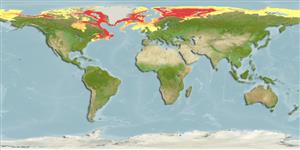Environment: milieu / climate zone / depth range / distribution range
Ecologia
marino demersale; distribuzione batimetrica 6 - 1750 m (Ref. 117245). Polar; 83°N - 41°N, 180°W - 180°E
Circumarctic (Ref. 11954). Northeast Atlantic: northeast Greenland, Jan Mayen Island, northern coasts of Iceland, Faroes-Shetland slope, northern part of Barents Sea, White Sea and around Spitsbergen. Northwest Atlantic: Arctic Canada to Labrador and Gulf of St. Lawrence; possibly to Cape Cod in Massachusetts, USA (Ref. 7251). Arctic Ocean: Kara Sea, western part of Laptev Sea, Beaufort Sea and Arctic Canada. Subspecies(?) Lycodes pallidus marisalbi in White Sea only (Ref. 4695).
Size / Peso / Age
Maturity: Lm ? range ? - ? cm
Max length : 26.0 cm TL maschio/sesso non determinato; (Ref. 4695); common length : 18.0 cm TL maschio/sesso non determinato; (Ref. 4695)
Short description
Chiavi di identificazione | Morfologia | Morfometria
Vertebre: 90 - 93. Pelvic fins small (Ref. 4695). Young with pale, yellowish-brown body, with 6-8 light and narrow cross bands which are more distinct on the dorsal fin; larger individuals lose the bands, becoming more or less uniformly colored (Ref. 4695).
Found on muddy bottoms (Ref. 4695). Benthic (Ref. 58426). Feeds mostly on endobenthic prey such as small bivalves, polychaetes and small crustaceans in addition to detritus. It seems to get the bulk of its food by burrowing in the sediment (Ref. 13532). Ripe females recorded in September in the Kara Sea (Ref. 4695). Minimum depth from Ref. 58018.
Life cycle and mating behavior
Maturities | Riproduzione | Spawnings | Egg(s) | Fecundities | Larve
Anderson, M.E., 1994. Systematics and osteology of the Zoarcidae (Teleostei: Perciformes). Ichthyol. Bull. J.L.B. Smith Inst. Ichthyol. 60:120 p. (Ref. 11954)
IUCN Red List Status (Ref. 130435)
Threat to humans
Harmless
Human uses
Strumenti
Special reports
Download XML
Fonti Internet
Estimates based on models
Preferred temperature (Ref.
123201): -0.9 - 4.9, mean 0.8 °C (based on 2262 cells).
Phylogenetic diversity index (Ref.
82804): PD
50 = 0.5000 [Uniqueness, from 0.5 = low to 2.0 = high].
Bayesian length-weight: a=0.00263 (0.00137 - 0.00504), b=3.22 (3.06 - 3.38), in cm total length, based on LWR estimates for this Genus-body shape (Ref.
93245).
Trophic level (Ref.
69278): 3.1 ±0.36 se; based on food items.
Resilienza (Ref.
120179): Medio, tempo minimo di raddoppiamento della popolazione 1.4 - 4.4 anni (Preliminary K or Fecundity.).
Fishing Vulnerability (Ref.
59153): Low vulnerability (16 of 100).
